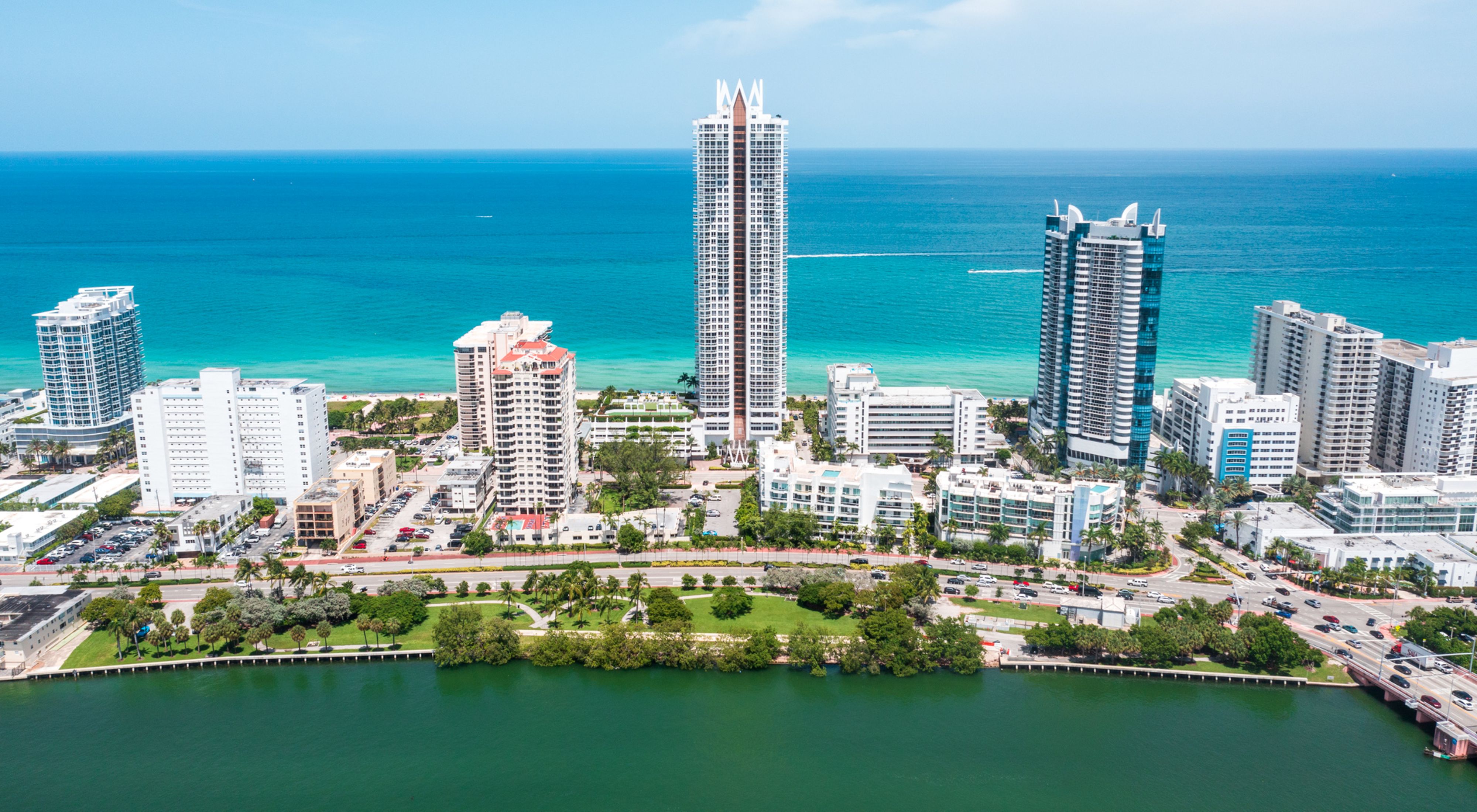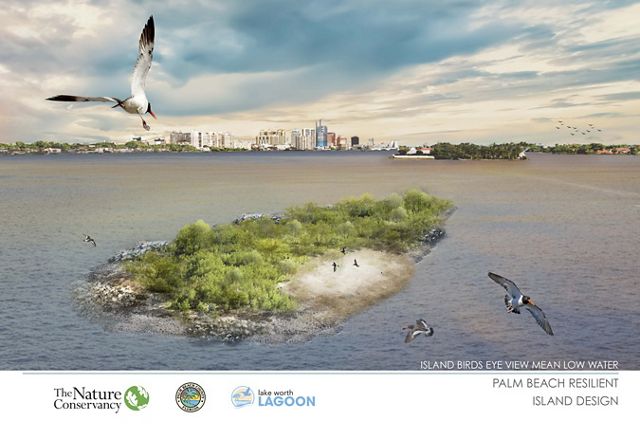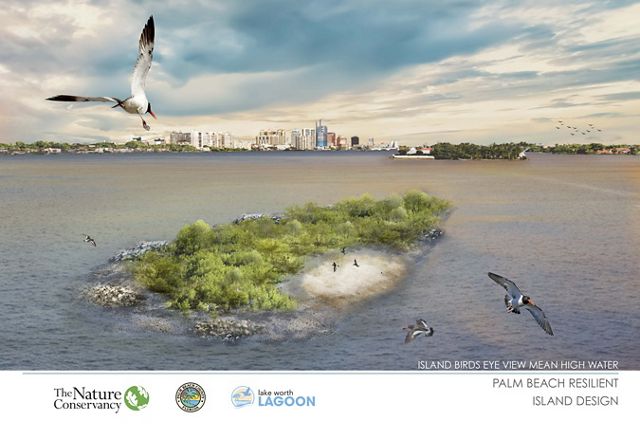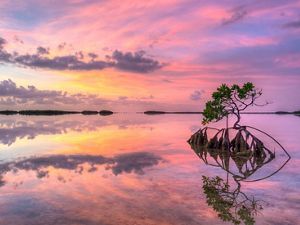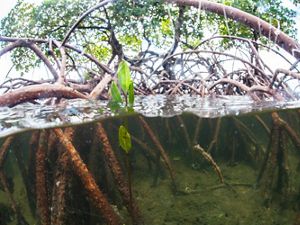Climate change is an urgent problem everywhere, and its impacts are especially pressing for the nearly 14 million people who live in Florida’s coastal counties. Rising sea levels and swelling storm surges threaten coastal communities with flooding and erosion, putting people and property at risk.
Natural infrastructure such as marshes, beaches, mangrove stands, coral reefs and oyster reefs can help protect Florida's coastline from such threats.
In Florida and beyond, TNC is protecting and restoring natural infrastructure to reduce the impact of coastal hazards related to climate change. Along with green and green-gray or hybrid infrastructure, these nature-based solutions can protect people and property while also providing wildlife habitat, recreational opportunities and economic benefits. By investing in nature-based solutions across Florida, TNC is demonstrating how local and state governments and key stakeholders can provide a win-win solution for coastal resilience on an even greater scale.

The Power of Natural Infrastructure
There are two equally important facets of climate action: climate mitigation and climate adaptation. Climate mitigation efforts focus on lowering carbon emissions and transitioning to renewable energy. These mitigation activities will continue to play a critical role in slowing the pace of climate change. Yet mitigation alone is not enough. Climate adaptation efforts are vital to reduce the threats posed by sea level rise, storm surge, flooding and coastal erosion brought on by climate change.
Typically, coastal regions are planning to adapt to rising sea levels and increasing storm surges with traditional solutions such as seawalls and breakwaters. But this gray infrastructure is expensive and carbon intensive. By contrast, nature-based solutions which includes natural, green, and hybrid infrastructure offer multiple benefits. In many cases, hybrid infrastructure is being used to provide greater long-term resilience and more cost-effective outcomes than we could achieve with traditional solutions alone.

We now have substantial evidence that natural ecosystems can protect the coastline and, in some cases, reduce storm surge beyond the capabilities of gray infrastructure. TNC scientists have found that in some regions, a healthy coral reef can reduce 97% of a wave’s energy before it hits the shore. And just 100 meters (328 feet) of mangrove trees can reduce wave height by 66 percent. A recent study, funded in part by TNC, found that mangroves in Florida protected approximately 625,000 people and prevented $1.5 billion in direct flood damages during Hurricane Irma in 2017.
In addition to coastal protection, natural ecosystems and nature-based solutions supply a host of other benefits, including improved water quality, recreational space and healthier fisheries. Trees and other green infrastructure also capture and store carbon, while providing critical habitat for Florida’s native flora and fauna.

Leading the Way to Coastal Resilience
Natural infrastructure plays a key role in protecting coastal areas in less urban locales as well. Projects such as our coral reef restoration work along Florida’s Atlantic coast and our oyster restoration projects in the Gulf of Mexico are advancing the science of nature-based solutions, while also supporting critical wildlife habitat. We are also developing innovative modeling tools to help inform decision making for climate adaptation, such as our coastal defense app, hosted on our coastal resilience website. And we continue to protect more natural spaces to ensure that nature can keep contributing to a resilient coast.
In addition to our work on the ground, TNC is taking a leadership role to advance nature-based solutions in Florida. We are an active participant in the Southeast Florida Regional Climate Change Compact, a four-county initiative established to coordinate climate mitigation and adaptation activities across Broward, Miami-Dade, Monroe, and Palm Beach Counties. As part of this engagement, we led the Compact’s Shoreline Resilience Working Group, which focuses on identifying and promoting healthy natural systems, engineered living shorelines and hybrid approaches to increase coastal resilience in southeast Florida and the Florida Keys.
TNC in Florida is partnering with Deltares USA to create a suite of regional resources to support the development of blueprints for community resilience for areas of Florida most impacted by climate change. These blueprints will establish natural and nature-based strategies to protect vulnerable communities from the threats of storm surge and sea level rise. Through this effort, we’ll also identify a pipeline of nature-based solutions that will provide the greatest return on investment.
Climate change is already altering Florida and its coastline. To manage present threats and adapt for the future, we must use all of the tools at our disposal in order to create a more resilient coastal ecosystem for Floridians—and nature-based solutions belong at the top of that list.

Putting Nature to Work in Urban Spaces
Coastal cities face some of the greatest risks from climate change. South Florida’s urban communities are among the most at-risk metropolitan regions in the United States. Infrastructure, homes, businesses and natural areas from Key West to Palm Beach lie at or near sea level, making them especially vulnerable to rising sea levels. Many parts of South Florida are already feeling the impacts of climate change, in the form of excessively hot days, king tides, sunny-day flooding and even changes in the migratory patterns of birds. Yet even in this heavily populated urban environment, nature has a role to play in creating resilient cities.
Coastal Resilience Projects
TNC is implementing several demonstration projects promoting nature-based solutions and natural infrastructure to benefit coastal resilience, flood risk reduction and climate adaptation in Florida.

Morningside Park
To demonstrate the value of nature-based solutions, TNC is working with the City of Miami to restore and enhance the waterfront of Morningside Park, a busy historic park on the shores of Biscayne Bay. The park and surrounding neighborhoods were established before modern stormwater conveyance and detention design standards. Now, extreme high tides are eating away at the shoreline and heavy rainfall events are inundating ball fields and the surrounding community.
With support from the Chubb Charitable Foundation, the Morningside Park Coastal Resilience Project will use a living shoreline to reduce flood risk to the park and nearby residents. This new green and hybrid infrastructure demonstration project will likely include restoration of mangroves and intertidal wetlands, the creation of elevated or upland earthen berms (natural barriers) planted with native vegetation, and the installation of limestone rip-rap to reduce wave energy as well as modern stormwater control structures to compliment drainage improvements for the park and surrounding neighborhood.
The project will enhance the beauty and resilience of Morningside Park. Meanwhile, it is expected to provide significant savings in avoided losses by protecting homes and businesses from future flooding during tropical storms and hurricanes. This demonstration project will benefit the City of Miami, and we hope it will influence policy and also serve as a model for other urban areas to follow as they must adapt to climate change.

Brittany Bay Park
TNC collaborated with the City of Miami Beach on the Brittany Bay Park Living Shoreline, Overlook and Park Renovation Project, with support from Florida Power & Light Company through its charitable arm the NextERA Energy Foundation. Read the press release about the groundbreaking on this exciting project.
Living shorelines help reduce the impacts from sea level rise and severe weather conditions on the park and local community. They also restore and enhance natural habitats for birds, fish and other marine life.

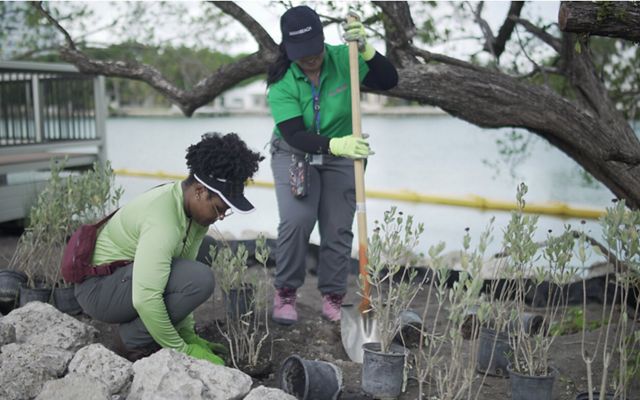
The city recently completed improvements to the existing seawall and bulkheads, and this project will go a step further toward adaptation, creating a living shoreline to enhance further habitat value and the park’s resilience to high tides and storm surges. With our conservation partners, we will establish an intertidal basin for mangroves and plant native vegetation and trees along the shoreline and throughout the park. This innovative project demonstrates how nature-based solutions can enhance gray infrastructure to create space for nature in heavily urbanized areas and further protect against climate-related hazards.


Quote: James Byrne

Implementing nature-based solutions like living shorelines and collaborating closely with partners and communities is critical to strengthening climate resilience.
In May 2023, TNC and partners were on hand for the Brittany Bay Park Living Shoreline Project Ribbon-Cutting Ceremony in Miami Beach. The event was well attended and highlighted this partner effort to improve coastal Miami with green solutions that will help to reduce flooding and wave impacts while also creating a natural habitat along the coastal ecosystem.
The native plants and limestone are working to reduce flooding impacts and help support a sustainable and safe environment for both people and nature.

Our Director of Strategy, James Byrne, attended the event and spoke to partners and the public on the importance of improving coastal resilience for both people and nature by employing green infrastructure. We thank our partners for collaborating to make part of the City of Miami Beach more resilient to climate impacts.
Learn more about the Brittany Bay Park Living Shoreline Ribbon-Cutting Ceremony.
Palm Beach Resilient Island
Natural and green infrastructure can be combined with gray to shore up vulnerable coastlines. But these nature-based solutions can also be combined with one another to create even more resilient systems. With support from the Batchelor Foundation and the Carrier Corporation, TNC is collaborating with Palm Beach County to restore and protect a small remnant island in Lake Worth Lagoon by arranging several nature-based solutions that have been successfully implemented in other nearby coastal restoration sites. Oyster reefs improve water quality and mangroves store carbon and provide important nursery habitat for fish and other aquatic organisms. In Lake Worth Lagoon, they may also protect against erosion that impacts upland areas including shorebird nesting habitat.


Mangroves are vulnerable to boat wakes and other hydrologic disturbances, however. To protect them, this demonstration project will minimize the use of limestone rip-rap and instead make use of oyster reefs. These will serve as a natural breakwater to reduce wave energy so that planted mangroves will become established, stabilize intertidal sediments, and limit erosion of upland areas of the island. It’s the first time this layered approach for nature-based solutions has been tested in South Florida. If it’s successful, it is a model that could be replicated throughout the Lake Worth lagoon and other areas to protect both natural habitat as well as homes, businesses and other built environments from destructive waves, storm surges and rising seas.
Help Us Make a Difference for Nature
For more than 60 years, we have been working to conserve the lands and waters on which all life depends in Florida. We have helped protect more than 1.2 million acres of vulnerable lands and waters in Florida, and we own and manage more than 40,000 acres including four preserves that are open to the public.

